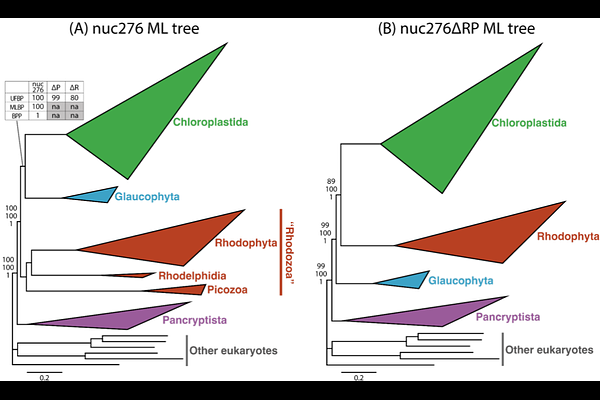Phylogenetic dissection provides insights into the incongruity in the tree of Archaeplastida between the analyses of nucleus- and plastid-encoded proteins.

Phylogenetic dissection provides insights into the incongruity in the tree of Archaeplastida between the analyses of nucleus- and plastid-encoded proteins.
Isogai, R.; Harada, R.; Nakayama, T.; Inagaki, Y.
AbstractArchaeplastida is defined as a taxonomic assemblage comprising three sub-clades, namely Chloroplastida, Glaucophyta, and Rhodophyta plus its non-photosynthetic lineages (collectively termed Rhodozoa here). The members of Archaeplastida are the descendants of the eukaryote that took up and transformed a cyanobacterial endosymbiont into a primary plastid. Archaeplastida has been well studied as one of the major eukaryotic assemblages in science, as this assemblage initiated the diversity and evolution of eukaryotic phototrophs, and are significant players in the past, modern, and future planetary environments. Recent phylogenetic analyses of multiple proteins (phylogenomic analyses) stably recovered the monophyly of Archaeplastida, but an uncertainty remains in the internal relationship among the three sub-clades. The phylogenomic analyses of nucleus-encoded proteins (nuc-proteins) put Rhodoza at the base of the Archaeplastida clade, albeit Glaucophyta was often inferred as the basal lineage in the phylogenomic analyses of plastid-encoded proteins (pld-proeins). In this study, we challenged the previously recognized but as-yet-explicitly addressed issue in the tree of Archaeplastida (ToA). The in-depth assessments conducted here revealed that taxon sampling can introduce phylogenetic artifacts, one from fast-evolving positions and the other from heterotachious positions, into the phylogenomic analyses of nuc-proteins and those of pld-proteins, respectively. Combining all the results achieved here, we propose the working hypothesis for the ToA, redefine the issue in the internal relationship among the three sub-clades, and provide future perspectives toward resolving the ToA.